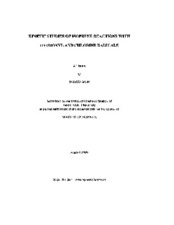| dc.creator | Suh, Inseon | |
| dc.date.accessioned | 2012-06-07T23:01:28Z | |
| dc.date.available | 2012-06-07T23:01:28Z | |
| dc.date.created | 2000 | |
| dc.date.issued | 2000 | |
| dc.identifier.uri | https://hdl.handle.net/1969.1/ETD-TAMU-2000-THESIS-S824 | |
| dc.description | Due to the character of the original source materials and the nature of batch digitization, quality control issues may be present in this document. Please report any quality issues you encounter to digital@library.tamu.edu, referencing the URI of the item. | en |
| dc.description | Includes bibliographical references (leaves 69-74). | en |
| dc.description | Issued also on microfiche from Lange Micrographics. | en |
| dc.description.abstract | Kinetic studies of the isoprene oxidation reactions initiated by the hydroxyl radical OH and the chlorine atom Cl have been investigated using a fast-flow reactor in conjunction with chemical ionization mass spectrometry (CIMS) and using laser photolysis/laser induced fluorescence (LP/LIF) detection. Both the CIMS and LP/LIF techniques were employed to investigate the reaction of isoprene with OH. The rate constants for the OH-isoprene reaction were measured in a pressure range of 70 to 112 Torr using the CIMS approach, with values of (9.7 [] 1.0) x 10⁻¹¹ to (10.5 [] 1.1) x 10⁻¹¹ cm³ molecule⁻¹ s⁻¹ at 298 [] 2 K. The LP/LIF method was used to measure the pressure dependent rate constants in a pressure range of 0.5 to 20 Torr. A low pressure limiting termolecular rate constant, k₀ = (6.98 [] 2.2) x 10⁻²⁶ cm⁶ molecules⁻² s⁻¹ and a high pressure limiting rate constant, k₁ = (1.04 [] 0.04) x 10⁻¹⁰ cm³ molecules⁻¹ s⁻¹ at 295 K were obtained by fitting the measured rate constants according to the Troe expression. The CIMS approach allowed monitoring of the OH-isoprene adducts directly. The observed bimolecular rate constant for the reaction between the OH-isoprene adduct and O₂ was determined to be (2.8 [] 0.7) x 10⁻¹⁵ cm³ molecule⁻¹ s⁻¹ at 75.5 Torr. In addition, the reaction of isoprene initiated by Cl atom has been studied, using the CIMS method. The reaction of isoprene with Cl proceeds via both the Cl addition to isoprene and hydrogen abstraction to form HCl. The pressure independent rate constant of (4.0 [] 0.3) x 10⁻¹⁰ cm³ molecule⁻¹ s⁻¹ for the Cl-isoprene reaction was obtained in a pressure range of 5 to 10 Torr. The branching ratio of (17.7 [] 3.2)% for the reaction of Cl with isoprene was derived by monitoring the formation of HCl in accordance with the consumed Cl concentrations. Furthermore, the overall rate constant for the reaction between the Cl-isoprene adduct and O₂ was determined as (1.0 [] 0.3) x 10⁻¹⁴ cm³ molecule⁻¹ s⁻¹, by modeling the reaction system in the experiments. Hence, in this work we have developed experimental techniques for the isoprene oxidation reactions with the OH radicals and Cl atoms, which should provide insight for understanding of the photochemical oxidation of isoprene in the atmosphere. | en |
| dc.format.medium | electronic | en |
| dc.format.mimetype | application/pdf | |
| dc.language.iso | en_US | |
| dc.publisher | Texas A&M University | |
| dc.rights | This thesis was part of a retrospective digitization project authorized by the Texas A&M University Libraries in 2008. Copyright remains vested with the author(s). It is the user's responsibility to secure permission from the copyright holder(s) for re-use of the work beyond the provision of Fair Use. | en |
| dc.subject | atmospheric sciences. | en |
| dc.subject | Major atmospheric sciences. | en |
| dc.title | Kinetic studies of isoprene reactions with hydroxyl and chlorine radicals | en |
| dc.type | Thesis | en |
| thesis.degree.discipline | atmospheric sciences | en |
| thesis.degree.name | M.S. | en |
| thesis.degree.level | Masters | en |
| dc.type.genre | thesis | en |
| dc.type.material | text | en |
| dc.format.digitalOrigin | reformatted digital | en |


